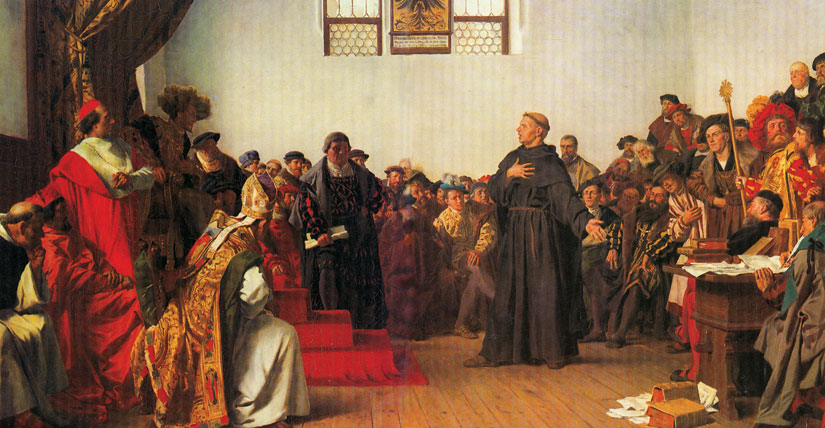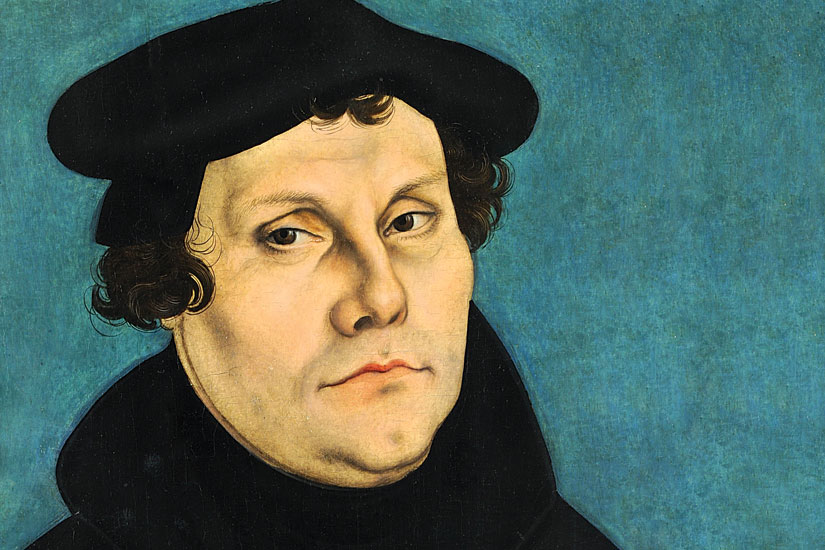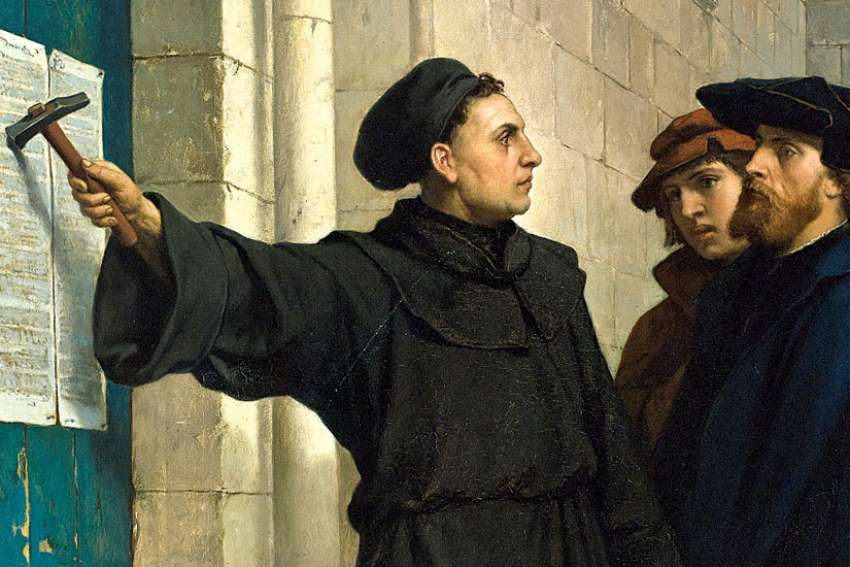Yet, that’s the position Pope Francis will find himself in on Oct. 31 as he visits the Protestant cathedral of Lund in southern Sweden to commemorate next year’s 500th anniversary since the birth of the Luther-inspired Reformation. The Pope’s visit marks a significant chapter in what has been a centuries-old religious wound. The pontiff will be pushing 500 years of division up the hill in the hope of seeing a new dawn from the top.
Luther never intended to split Western Latin Christianity. He was an Augustinian Monk and a product of his Catholic heritage.
Like plenty of Catholics before and since, he was outraged whenever Church authorities found creative uses for the faith and devotion of ordinary people. When Pope Leo X started offering indulgences in return for alms — money to be used to build the new St. Peter’s in Rome — the university professor was roused.
His 95 Theses, pinned to the door of Wittenberg Cathedral in October of 1517, were withering on the subject of “certain hawkers of indulgences (who) cajole money.”
But Luther’s thinking on many subjects was decidedly and enduringly Catholic. He expounded on the idea of the “priesthood of the people.” Being a Christian for Martin Luther wasn’t a state of servitude. Baptism should mean we are raised up and freed for direct communion with God through our Lord and Saviour. There isn’t a Catholic bishop today who would disagree.
Luther taught that marriage is a good thing. He did his best to dispel the notion that the only way to be a good Christian was to become a nun or a monk. Good people raising families, guided by Christian values, answer a call from God, Luther taught. Sound familiar?
He imagined families as small churches gathered to pray, study and work together. As a man of his time, he imagined fathers as the sole authority in every family. But the deeper truth is that those families were to be charged with their own salvation and the salvation of the world.
Luther’s aim was to get closer to Jesus — to know, understand and love the Son of God. But he wanted that not just for himself — a scholar with excellent command of Church Latin — but for everybody. That’s why he translated the Bible for his fellow German Christians and encouraged them to read and study it. He had discovered something radical about the Christian life by reading the Bible and he wanted to share that experience.
Luther, who was 33 in 1516, didn’t want to split the Church. He wanted to pull it together through the bonds of faith, which he thought must be stronger than the mere exercise of authority by a distant pope.
The wound that the Reformation opened has been healed somewhat over the last 50 years, and the ecumenical prayer service in Lund will be the culmination, at least so far, of a joint project which began with Unitatis Redintegratio, the 1964 Decree on Ecumenism from the Second Vatican Council. Lutheran bishops were guests at Vatican II and they were ready with their Catholic colleagues to tackle ecumenical dialogue.
In 1978 Catholics and Lutherans agreed that the Eucharist isn’t some sort of re-enactment of Christ’s sacrifice on the cross and that both Churches believe in the real presence of Christ in the Eucharist. The 1978 ecumenical dialogue document on “The Lord’s Supper” directed Catholics to more often offer Communion in both bread and wine and told Lutherans they should celebrate the Eucharist weekly.
Even earlier, in 1972, the Malta Report recommended that Lutherans and Catholics, based on growing theological agreement, should occasionally be allowed to share in the Eucharist together.
Since the Second Vatican Council, theologians and bishops have demonstrated over and over that Catholics and Protestants share substantial, important common ground and the ties that bind are greater than the divisions of the 16th century. But the weight of 500 years of history has been too great to move even for official dialogues between our best scholars and wisest bishops.
“We will remember together, sing together, pray together and hopefully plan together as well. This is not just about what happened. This is about where we are and where we’re going together,” Zion Lutheran Church pastor Rick Pryce told The Catholic Register.
 Martin Luther addresses the Diet of Worms in 1521 where he refuses to recant his 95 theses. (Photo from WikiCommon)
Martin Luther addresses the Diet of Worms in 1521 where he refuses to recant his 95 theses. (Photo from WikiCommon)
Zion is Canada’s oldest Lutheran parish, organized in Lunenburg, N.S., in 1772. On Nov. 19 at 2:30 p.m. Zion will also mark the 500th anniversary of the Reformation, hosting Halifax-Yarmouth Roman Catholic Archbishop Anthony Mancini in an ecumenical prayer service. Anglicans, who today are in full communion with Canada’s Lutherans, will also be there.
The Christians Pryce leads in Lunenburg aren’t much exercised by the 16th-century split of Western, Latin Christianity.
“There’s a lot of folks on the ground who have moved past these issues a long time ago,” said Pryce. “And it’s the structures that are finally starting to catch up.”
When Luther pinned 95 theses to the cathedral door in Wittenberg, he was proposing topics for debate — a normal, weekly practice in a university town. For years the Catholics and Lutherans couldn’t even agree on what they disagreed on. But by 1545, when the Catholics called their 19th ecumenical council in the little town of Trent to deal with the Protestant uprising, the bishops had decided the real problem was the doctrine of justification.
How are we justified — that is, put in line and headed for salvation in Christ? At Trent, the ecumenical fathers condemned what they thought was the Lutheran position.
“If any one saith, that by faith alone the impious is justified; in such wise as to mean, that nothing else is required to co-operate in order to the obtaining the grace of Justification, and that it is not in any way necessary, that he be prepared and disposed by the movement of his own will; let him be anathema.”
To be anathema (an abomination and a disgrace) was to be excommunicated. It took until Oct. 31, 1999 for Lutherans and Catholics to re-examine what they really believe about justification, withdraw their mutual condemnations of one another and set out a common understanding of the path to salvation. But it’s not as if the 1999 Joint Declaration on the Doctrine of Justification has had any immediate, practical effect on where Lutherans and Catholics go to Church on Sunday mornings, or what they do once they get there.
The struggle for unity is something we should learn to enjoy, said Canadian Council of Churches executive director Rev. Dr. Karen Hamilton.
“The joy is in engaging in it,” she said. “It’s a way in which we understand that we’re all centred in Jesus Christ but have true history through the study of Scripture and prayer and tradition and lived experience.”
Ecumenism isn’t some massive exercise in forgetting the central event in modern European history. The first job of ecumenical theology is in fact to remember how and when we became divided.
“You’ve got to leave those battles behind forever and ever and truly lament them,” said Hamilton. “Thousands and thousands and thousands of people died. This is truly to be lamented and, if nothing else is learned, pray God help us we never do such a thing again.”
The Reformation is simply too important to gloss over, said Conrad Grebel University and Toronto School of Theology history professor Troy Osborne.
“There was a tendency for a while to downplay it,” Osborne said. “To say it was about ideas and it didn’t affect most people’s lives.”
 Martin Luther (1528) by Lucas Cranach the Elder (Public Domain)
Martin Luther (1528) by Lucas Cranach the Elder (Public Domain)
Those ideas in fact shaped our modern consciousness and sense of who we are. The first thing that happened in both the Protestant Reformation and the Catholic Counter-Reformation was a positive engagement of ordinary people in religious ideas. The Council of Trent’s first practical act was to assemble and publish a catechism so that all Catholics would know, or be able to find out, what Catholics believe. Luther’s translation of the Bible into German created the conditions for people to interpret the story of their salvation for themselves.
“People’s lives changed as a result of greater Church involvement in their lives after the Reformation,” said Osborne. “Church discipline, Trent’s mandates on how to educate priests — this all resulted in long-term decreases in murder, decreases in illegitimate pregnancies and things like that. It really changed the behaviour of Europeans… Individuals became their own authority, but they were also supposed to take responsibility for their own religious education."
After the Reformation, people learned to read and to argue their positions on Church teaching.
“You have to understand that people are concerned with whether or not they go to Heaven or go to hell. Then these debates make sense,” said Osborne.
“The Reformation is still affecting us deeply,” said Notre Dame University’s Brad Gregory, a leading Catholic historian of the Reformation. “It’s a mistake to think about the Reformation as simply a dramatic change in religion. What it really does in the long term is give us our modern understanding of what religion is.”
It’s no accident that after the Reformation and the wars of religion that followed we see the emergence of individual rights and nation-states with a mandate to protect and promote those rights.
“Separation of Church and state, making religion an individual choice, political rights that protect people’s ability to believe what they want to believe so long as they obey the law — that’s absolutely crucial, and the privatizing and individualizing of religion,” said Gregory.
The ideas of religious toleration and individual rights which took shape in the Enlightenment are inevitable in hindsight, but would have shocked the first reformers. To avoid conflict and coercion, Western society simply decided that worship and belief are private matters that shouldn’t inform or shape public life in any direct way.
“The assumption behind that is that people can come to a significant degree of agreement about fundamental matters pertaining to how human life should be lived and what the common good looks like if they set those religious things aside,” said Gregory. “This is the great, central dream of the Enlightenment, that through our reason alone we share enough to come together and discuss and dialogue. We will hammer it out and everybody will agree what a family should be, or who constitutes a person, or what marriage should look like, or whatever. But it seems to me clear that this has frayed if not unravelled in very significant ways.”
Gregory points to an American election unfolding in 2016 with no consensus on some of issues.
In 2013 the Pontifical Council for Promoting Christian Unity and the Lutheran World Federation published “From Conflict to Communion.”
“What happened in the past cannot be changed, but what is remembered of the past and how it is remembered can, with the passage of time, indeed change,” said the document.
And if the purpose of remembering is communion?
“Protestantism, Catholicism and Orthodoxy are crucial parts of the reality of this country. So we have to talk. We have to discuss,” said Hamilton.
“The Reformation took place” is Mancini’s starting point. “Was there a need for one? Sure there was. There still is.”
REFORMATION: A TIMELINE
Oct. 31, 1517: Martin Luther, an Augustinian monk, posted a list of 95 theses on the cathedral door in Wittenburg, announcing topics for debate.
January to May, 1521: At the Diet of Worms, Holy Roman Emperor Charles V calls on Luther to recant criticisms of the Church and the papacy Luther made in his 1520 book The Christian Nobility of the German Nation. Luther refuses, is declared a heretic and excommunicated by Pope Leo X.
1529: At the Marburg Colloquy, Luther debates Ulrich Zwingli on the real presence in the Eucharist. Luther defended a sacramental view of the union of the body and blood of Christ in the bread and wine of the Eucharist.
1530: Lutheranism acquires its doctrinal starting point with publication of the Augsburg Confession.
1536: John Calvin publishes the Institutes of the Christian Religion in Geneva. Calvin’s more radical view of a Church without Rome spreads to France, England and Scotland.
1545 to 1563: The Council of Trent condemns Protestantism and defines Catholic teaching in direct contrast to Protestantism.
1546: Martin Luther, age 62, dies in Eisleben, Germany.
1555: Under the principle of cuius regio, eius religio ( “whose region, his religion,”) the Peace of Augsburg gives local rulers the right to determine the official church of their region.
1595: Emperor Ferdinand II tries to stamp out Protestantism in Austria, beginning the 30 Years’ War.
1611: The English Reformation, begun under Henry VIII, culminates in the King James Bible and standardization of worship under Elizabeth I.
1648: The Peace of Westphalia extends the cuius regio, eius religio principle beyond Lutherans to Calvinists and others, ending the wars of religion.
Nov. 21, 1964: The Second Vatican Council makes ecumenical unity among Christians an imperative for all Catholics.
Oct. 31, 1999: The Pontifical Council for Promoting Christian Unity and the Lutheran World Federation declare theological agreement on questions of justification and sanctification.


